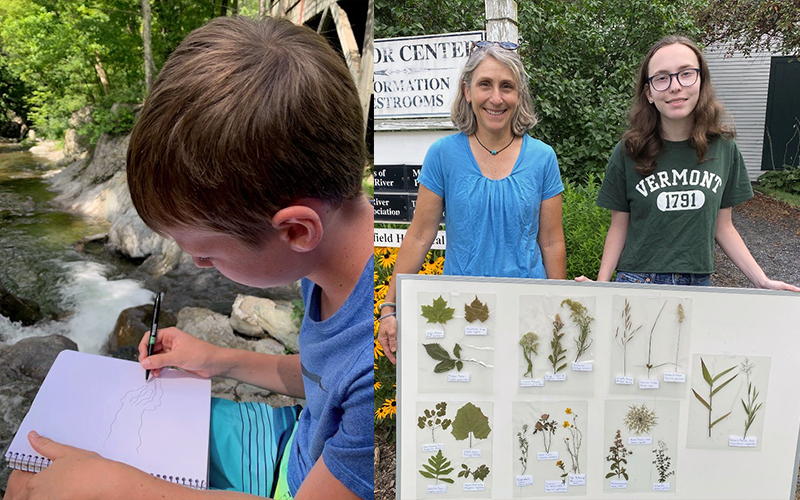Saturday, August 28, is the 10-year anniversary of Tropical Storm Irene when around 6 inches of rain fell in the Mad River watershed in a matter of hours, causing the river to crest at ~19 feet at the gage in Moretown, a full 10 feet above flood stage. The damage to infrastructure and people’s homes and businesses was significant. “After Irene, the community came together to take care of each other,” recalled Katie Sullivan, Friends of the Mad River board member and Warren School teacher.
“The way people pitched in and helped, however they could, was a true testament to this community’s spirit.” That spirit of community central to the Irene recovery effort continued in the efforts for resiliency over the decade since,” she added.
“Town board representatives planning and acting together across town lines as part of the Ridge to River initiative, homeowners enhancing their homes and driveways with Storm Smart, town reps and road crews upgrading culverts and improving roads, Mad River Watch volunteers dedicating time and energy to understand the river,” listed Corrie Miller, Friends of the Mad River (FMR) director. “Over the last decade, our community has worked hard, learned a lot about the opportunities we have to shape our future and made great strides together towards resilience.”
TAKES A VILLAGE
Last Sunday and Monday, 23 FMR Mad River Watch volunteers visited 21 field sites across The Valley in order to monitor water quality, make detailed environmental observations and leave the site better than they found it. It was their sixth and final field exploration this summer. As Lisa Koitzsch, Mad River Watch coordinator, greeted volunteers on their return from their last field day, they were reflective on their learning and experience, putting pieces together from a summer’s worth of observations and asking questions about what more they can do to support a clean river and resilient watershed.
“With our new directive this year as River Watchers to spend more time making observations of the natural surroundings along the riverbanks, we found a new appreciation of the diversity and resiliency of plant life within the sometimes challenging environment bordering the river,” said Julie Westervelt, Warren, about her experience volunteering with her daughter, Ingrid. “Taking a closer look has helped us understand the beauty of this special ecosystem that’s such an integral part of our community here in The Valley.”
A young Warren volunteer, thinking in geologic time, annotated his drawing of the Freeman Brook site with: “The big rock was carved out by water and made three water shoots over time.” A Fayston mother/daughter volunteer duo also noticed changes to the Ward Access landscape caused by water, but in a much shorter time frame: “A growing sand bar upstream will likely disappear in the rain to come tonight,” and added, “Changes to the beach from the rain are lovely to watch.”
A Warren volunteer took note of a change at Rice Brook since her last field day that will likely enhance trout habitat: “The tree with the holes fell over and has become part of the stream.” Another volunteer in Waitsfield, on the other hand, noted a change that may reduce the quality of aquatic habitat: “The property was mowed or hayed for the first time this summer and only a narrow riparian buffer was left by the mower.”
A summer Warren resident, noticed the seasonal changes at the Wabanaki Conservation Area: “Interesting how my site has changed in two months -- vegetation, water levels and traffic on 100” -- but also worked with the town of Warren and VTrans to cleanup the Kingsbury Bridge.
Volunteers removed beer cans, baby diapers, household trash and takeout containers from stream sides and marveled at fleeting wildlife including cedar waxwings, red-winged blackbirds, geese, mourning doves and an Eastern kingbird, as well as tent caterpillars, water striders, a groundhog and unknown animal holes and unidentified scat.
In consideration of the greener sides of biodiversity, Julie and Ingrid Westervelt collected and preserved physical examples of plants at the Warren covered bridge. “Many are common plants we see along our local roadsides, and we were curious to know more about them. We were pleasantly surprised to find a good mix of native species from flowers such as Common Boneset and St. John’s wort to trees such as balsam, poplar and sugar maple and non-natives such as smooth bromegrass and chicory to clematis and rugosa rose,” said Julie Westervelt.
Water temperatures ranged from a low of 63°F at Warren Falls to a high of 71°F at the USGS gage in Moretown on Monday. This fall, FMR will compile other data and observations and share key findings and highlights in The Valley Reporter and online at friendsofthemadriver.org/madriverwatch. “Paying attention to a changing landscape is a critical step as we seek to understand opportunities to build the watershed’s resilience to a changing climate,” remarked Corrie Miller. “The Mad River Watch volunteers, landowners and funders [give] their energies to this resilience work and continue to make our community better.”







